
The Endocannabinoid System: What It Is and How It Works
Due to the recent surge in the popularity of CBD, there has been a huge increase in public curiosity about the endocannabinoid system.
What is the endocannabinoid system? How does it work? How does it affect my health?
Is it even a real thing, or is it all just a bunch of hogwash created by advertisers to sell CBD products?
If you’ve found yourself pondering these questions, you’ve come to the right place!
In this guide, we’ll take an in-depth look at the endocannabinoid system and break it down into simple terms to help you understand what it is, how it works, and how CBD may work hand-in-hand with it to keep you functioning at your best.
I hope you brought your swim trunks – we’re about to dive right in!
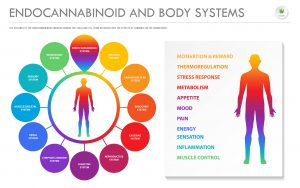
What Is the Endocannabinoid System?
You’ve heard of the nervous system. You’ve heard of the digestive system. And we’ve ALL heard of the reproductive system (thanks, awkward high-school sex ed classes!).
But the endocannabinoid system probably wasn’t covered in science class when you were growing up.
That’s because it wasn’t discovered until the 1990s – and even after being discovered, it’s taken a long time for scientists to understand the role it plays in human life.
But let’s get one thing straight right off the bat: the endocannabinoid system is just as real as the digestive, nervous, or reproductive system.
This short video does a great job of explaining the endocannabinoid system in an easy-to-understand way:
The endocannabinoid system, or ECS for short, is basically a big communication network that’s made up of receptors spread throughout your body.
These receptors are activated (switched on or off) by cannabinoids.
Now, just what exactly are cannabinoids – and why does the word “cannabinoid” sound so much like “cannabis”?
Let’s start with the second question.
Cannabinoids were given their name when they were discovered by researchers studying the cannabis plant way back in the 1940s. [1]
Those researchers were working to identify THC, the specific cannabinoid which produces the “high” associated with smoking marijuana.
Little did those scientists know, THC isn’t the only cannabinoid in existence – and the cannabis plant isn’t the only source of cannabinoids, either.
In fact, recent research has identified cannabinoids in everyday foods like broccoli, carrots, and even chocolate! [2]
But, to be fair, the cannabis plant is the richest source of cannabinoids in the world, containing more than 120 different types. [3]
So now for the bigger question: what are cannabinoids?
The word cannabinoid can be used to refer to any chemical substance which interacts with your body’s cannabinoid receptors. [4]
Most cannabinoids come from plants – these are called phytocannabinoids. CBD and THC are the most well-known phytocannabinoids, but many more exist.
Your body also produces some cannabinoids of its own, called endocannabinoids. These include anandamide and 2-AG.
To borrow an old analogy, you can think of cannabinoids as keys, and your body’s cannabinoid receptors as locks – when the cannabinoid “keys” bind to the receptor “locks,” that’s when you feel your ECS working its magic.
Research on the ECS is ongoing, and scientists still don’t fully understand exactly how it works.
But existing research shows without a doubt that the ECS is involved in many aspects of your everyday life, including:
- Memory [5]
- Appetite and metabolism [6]
- Mood [7]
- Pain perception [8]
- Motivation and reward [9]
- Immune function [10]
- Sleep [11]
You may be wondering how one single system is able to affect so many different parts of your existence.
Well, cannabinoid receptors are extremely widespread throughout your body – your brain, organs, muscles, and skin are all chock-full of them.
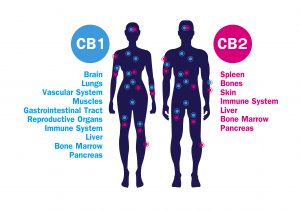
There are two types of cannabinoid receptors in the ECS: CB1 and CB2. For the purposes of this article, we won’t go into the differences between them, but suffice it to say that they’re pretty much EVERYWHERE in your body!
Due to this wide reach, the ECS is tied into multiple body systems, including the nervous, cardiovascular, endocrine, digestive, and immune systems.
This allows the ECS to serve as a “master regulator” of numerous body functions, both physical and emotional. [12]
Scientists believe the primary purpose of the ECS is maintaining homeostasis, or a state of balance in your body.
If you’re in pain, your body can release endocannabinoids in your nervous system to reduce your discomfort.
After a large meal, endocannabinoids can communicate with your nervous system to regulate your appetite and let you know that you’re full. [13]
Oh, and have you ever heard of a “runner’s high”?
It was once thought to be the result of an endorphin rush after extended periods of exercise, but new research shows that it actually has more to do with increased levels of anandamide, which is – you guessed it – an endocannabinoid! [14]
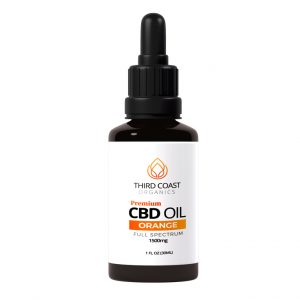
Are you curious about CBD, but just haven’t found the right time to try it? Well here’s your chance: Use code ECS15 to get 15% OFF all Third Coast Organics CBD oil tinctures!
These examples are just the tip of the iceberg when it comes to the ECS’s many functions.
So, whether you use cannabis or not, your ECS is active every day, affecting countless aspects of your physical and emotional wellbeing.
But when the ECS isn’t working right, that’s when problems start.
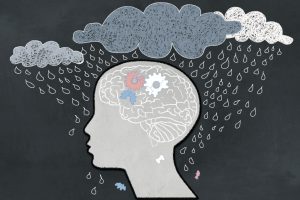
Clinical Endocannabinoid Deficiency
Clinical Endocannabinoid Deficiency (CED) arises when the ECS isn’t functioning properly, either because of low endocannabinoid levels or impaired cannabinoid receptors.
The theory behind CED is that, when your ECS function is compromised, you experience “a lower pain threshold… along with derangements of digestion, mood, and sleep,” among other problems. [15]
CED is suspected to be an underlying issue that contributes to many health conditions with no specific known cause, including depression, fibromyalgia, irritable bowel disease, migraines, multiple sclerosis, Parkinson’s disease, and more. [15]
The concept of CED was originally hypothetical, but recent academic research has “provided a firmer foundation for the theory,” and “clinical data have also produced evidence for decreased pain, improved sleep, and other benefits to cannabinoid treatment” (Russo, 2016).
…Which brings us to the topic of CBD!

Using CBD to Treat Clinical Endocannabinoid Deficiency
When it comes to treating CED, not all CBD supplements are created equal.
Most CBD products fall into 1 of 3 categories: full spectrum, broad spectrum, or isolates.
- Full spectrum: Contains CBD along with the entire range of naturally occurring compounds found in the cannabis plant (can contain up to 0.3% THC).
- Broad spectrum: Contains CBD along with some or most of the naturally occurring compounds found in cannabis (all THC is removed).
- Isolates: Contains CBD alone, with no other plant compounds, cannabinoids, or terpenes.
Research shows that the greatest therapeutic benefits come from full-spectrum or broad-spectrum CBD. This is due to the entourage effect – a phenomenon wherein all of the plant compounds, when working together, produce a greater effect than any one of those compounds could produce alone. [16]
So, if you’re trying to address CED, look for a CBD oil that’s full-spectrum (like this one) or broad-spectrum (like this one).
Theoretically, CED can be treated in two ways.
One way would be to increase the body’s endocannabinoid levels – which CBD does.
CBD has been shown to boost levels of anandamide, one of the two cannabinoids naturally produced by your body. [17]
Low anandamide is associated with anxiety, depression, migraines, irritable bowel disease, multiple sclerosis, diabetic neuropathy, and more.
By increasing the amount of anandamide in your body, CBD supplementation may help to moderate the severity of these conditions. [15]
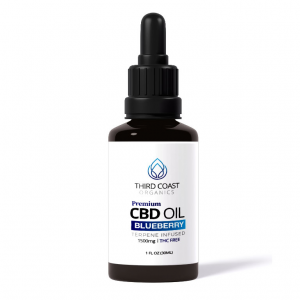
Psst… Don’t forget that for a limited time, you can get 15% OFF all Third Coast Organics CBD oil tinctures by using code ECS15 at checkout!
The other way to treat CED would be to improve the functionality of the body’s cannabinoid receptors – which, according to research, CBD may also help to do!
See, many CED-related conditions stem from “overactive” cannabinoid receptors, usually of the CB1 variety. [18]
Dysfunctional CB1 activation is associated with obesity, PTSD, anxiety, depression, fibromyalgia, and chronic pain. [19]
Thankfully, CBD is a “negative modulator” of the CB1 cannabinoid receptor.
In English, this means CBD can act as a “dimmer switch” if those receptors become hyperactive, making CBD a promising potential treatment for the above conditions. [20]

Beat CED With CBD
Say that five times fast… 😉
Like I said before, research on the ECS is still in its early stages. The same is true of CBD, for that matter – more is being learned every day.
As the amount of research grows, so does the long list of health conditions that have been found to respond positively to CBD supplementation.
So the fact that CBD has become such a popular supplement is no big surprise!
Given the overwhelmingly positive reports of millions who have found relief from their ailments by using CBD, it seems that the research is just now catching up to what many people have already experienced firsthand.
Give it a try for yourself and see what all the hype is about! Click here to shop our wide variety of premium, organic, USA-grown-and-processed CBD products.
And don’t forget to use code ECS15 to get 15% OFF our CBD oil tinctures!
If you have friends or family members who could benefit from CBD, share this article on social media – you just might change their lives.
Your turn! Have you tried CBD? How has it impacted your life and wellbeing? Let us know in the comments below.
References
- International League Against Epilepsy (2019). The discovery of the endocannabinoid system: Centuries in the making. Retrieved from https://www.newswise.com/articles/the-discovery-of-the-endocannabinoid-system-centuries-in-the-making
- Gertsch, J., Pertwee, R., & Di Marzo, V. (2010). Phytocannabinoids beyond the cannabis plant – do they exist? Retrieved from https://www.ncbi.nlm.nih.gov/pmc/articles/PMC2931553/
- Morales, P., Hurst, D., & Reggio, P. (2017). Molecular targets of the phytocannabinoids: A complex picture. Retrieved from https://www.ncbi.nlm.nih.gov/pmc/articles/PMC5345356/
- Alcohol and Drug Foundation. (2020). Cannabinoids. Retrieved from https://adf.org.au/drug-facts/cannabinoids/
- Lunardi, P., Souza, L., Santos, B., Popik, B., & Alvares, L. (2020). Effect of the endocannabinoid system in memory updating and forgetting. Retrieved from https://www.sciencedirect.com/science/article/abs/pii/S0306452220304887
- Watkins, B., & Kim, J. (2015). The endocannabinoid system: Directing eating behavior and macronutrient metabolism. Retrieved from https://www.ncbi.nlm.nih.gov/pmc/articles/PMC4285050/
- Hill, M., & Gorzalka, B. (2009). The endocannabinoid system and the treatment of mood and anxiety disorders. Retrieved from https://pubmed.ncbi.nlm.nih.gov/19839936/
- Manzanares, J., Julian, M., & Carrascosa, A. (2006). Role of the cannabinoid system in pain control and therapeutic implications for the management of acute and chronic pain episodes. Retrieved from https://www.ncbi.nlm.nih.gov/pmc/articles/PMC2430692/
- Parsons, L., & Hurd, Y. (2015). Endocannabinoid signaling in reward and addiction. Retrieved from https://www.ncbi.nlm.nih.gov/pmc/articles/PMC4652927/
- Pandey, R., Mousawy, K., Nagarkatti, M., & Nagarkatti, P. (2009). Endocannabinoids and immune regulation. Retrieved from https://www.ncbi.nlm.nih.gov/pmc/articles/PMC3044336/
- Kesner, A., & Lovinger, D. (2020). Cannabinoids, endocannabinoids and sleep. Retrieved from https://www.ncbi.nlm.nih.gov/pmc/articles/PMC7388834/
- Sallaberry, C., & Astern, L. (2018). The endocannabinoid system, our universal regulator. Retrieved from https://www.jyi.org/2018-june/2018/6/1/the-endocannabinoid-system-our-universal-regulator
- Acharya, N., Penukonda, S., Shcheglova, T., Hagymasi, A., Basu, S., & Srivastava, P. (2017). Endocannabinoid system acts as a regulator of immune homeostasis in the gut. Retrieved from https://www.pnas.org/content/114/19/5005
- Lavelle, J. (2015). New brain effects behind “runner’s high”. Retrieved from https://www.scientificamerican.com/article/new-brain-effects-behind-runner-s-high/
- Russo, E. (2016). Clinical endocannabinoid deficiency reconsidered: Current research supports the theory in migraine, fibromyalgia, irritable bowel, and other treatment-resistant syndromes. Retrieved from https://www.ncbi.nlm.nih.gov/pmc/articles/PMC5576607/
- Ferber, S., Namdar, D., Hen-Shoval, D., Eger, G., Koltai, H., Shoval, G., . . . Weller, A. (2020). The “Entourage Effect”: Terpenes coupled with cannabinoids for the treatment of mood disorders and anxiety disorders. Retrieved from https://www.ncbi.nlm.nih.gov/pmc/articles/PMC7324885/
- Bedse, G. et al. (2018). Therapeutic Endocannabinoid Augmentation for Mood and Anxiety Disorders: Comparative Profiling of FAAH, MAGL, and Dual Inhibitors. Translational psychiatry, 8 (1), 92.
- Cinar, R., Gochuico, B., Iyer, M., Jourdan, T., Yokoyama, T., Park, J., . . . Kunos, G. (2017). Cannabinoid cb1 receptor overactivity contributes to the pathogenesis of idiopathic pulmonary fibrosis. Retrieved from https://www.ncbi.nlm.nih.gov/pmc/articles/PMC5396529/
- Gaia, R. (2020). Cannabinoid receptor 1 (cb1) basics. Retrieved from https://gaiaguru.co.uk/cannabinoid-receptor-1-basics/
- Ethan, R. (2004). Clinical endocannabinoid deficiency (cecd): Can this concept explain therapeutic benefits of cannabis in migraine, fibromyalgia, irritable bowel syndrome and other treatment-resistant conditions? Retrieved from https://pubmed.ncbi.nlm.nih.gov/15159679/

Thomas Allred is a freelance writer and licensed Physical Therapist Assistant with a BA in psychology from Texas A&M University. He developed a keen interest in CBD during a 10-year struggle with uncontrolled epilepsy. When he’s not writing, Thomas enjoys cooking, playing guitar very badly, and exploring Austin with his wife and dog. Find him online at www.thomasallredwriting.com.

